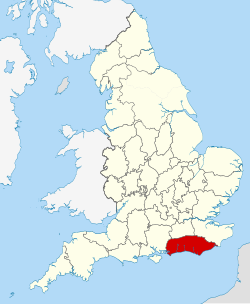 | |
| Continent | Europe |
|---|---|
| Region | Southern England |
| Area | |
| • Total | 3,783 km2 (1,461 sq mi) |
| Coastline | 220 km (140 mi) |
| Borders | |
| Highest point | Blackdown 280 m (919 ft) |
| Longest river | River Medway (shared with Kent) 113 km (70 mi) Longest river entirely within Sussex is the River Arun 60 km (37 mi) |
| Largest lake | Bewl Water (shared with Kent) 3.12 km2 (1.20 sq mi)[1] Longest inland body of water entirely within Sussex is Ardingly Reservoir 0.8 km2 (0.31 sq mi) |
| Climate | Oceanic "British" climate |
| Terrain | hills, downland, woodlands, lowlands, wetlands, coastal, marine, urban |
| Natural resources | iron, fish, timber, wildlife, wind power, shale gas, oil |
| Natural hazards | European windstorms, floods, few and small tornadoes |
| Environmental issues | Biodiversity loss, climate change, habitat fragmentation, rising sea levels, renewable energy, waste disposal, water pollution, population density |
| References | |
| [2] | |
Sussex is a historic county and cultural region in the south of England corresponding roughly in area to the ancient Kingdom of Sussex. It is bounded on the north by Surrey, north-east by Kent, south by the English Channel, and west by Hampshire, and is divided for local government into West Sussex and East Sussex and the city of Brighton and Hove. The city of Brighton & Hove was created a unitary authority in 1997, and was granted City status in 2000. Until then Chichester had been Sussex's only city. By convention, Chichester is Sussex's capital city and Lewes is Sussex's county town.[3][4]
Sussex encompasses approximately 3,783 square kilometres (1,461 sq mi). It is 120 km (75 mi) long and is between 35 and 40 km (22 and 25 mi) wide. For comparison, Sussex is slightly larger than the neighbouring county of Kent or Cornwall or the Indian state of Goa and is 50 per cent larger than Luxembourg. Sussex has a population of about 1.6 million,[5][nb 1] about the same as Goa or the US state of Idaho and about three times the population of Cornwall.
Sussex has three main geographic sub-regions, each orientated approximately east to west. In the south-west of the county lies the fertile and densely populated coastal plain. North of this lie the rolling chalk hills of the South Downs, beyond which lies the well-wooded Sussex Weald.
- ^ "Bewl Water Reservoir – Facts and figures" (PDF). Bewl Water Estate. Retrieved 21 June 2012.
- ^ "Habitats - Habitats Overview". Sussex Biodiversity Partnership. Retrieved 14 April 2012.
- ^ "About Sussex". Sussex County Flag. 11 March 2015. Retrieved 2 February 2019.
- ^ Ewald 1870, p. 64
- ^ Office for National Statistics. "Census 2011 result shows increase in population of the South East". Retrieved 4 December 2012.
Cite error: There are <ref group=nb> tags on this page, but the references will not show without a {{reflist|group=nb}} template (see the help page).
